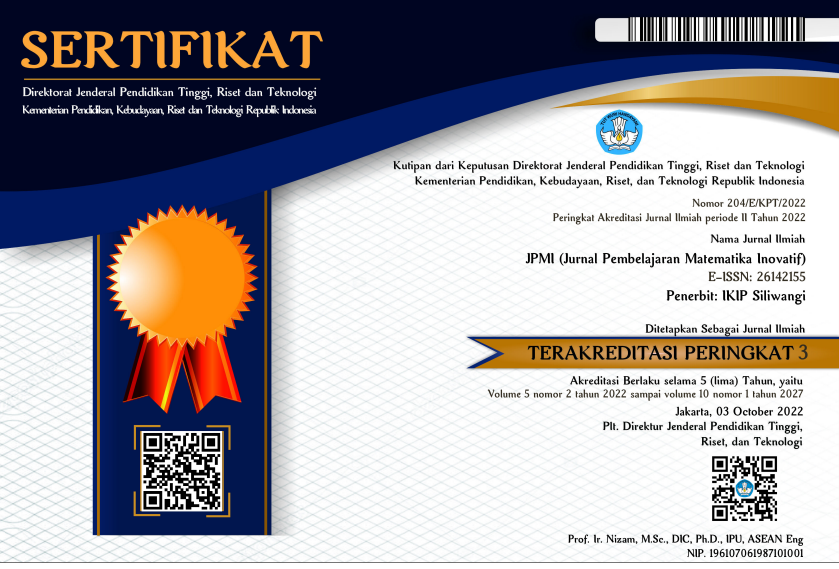Rasch model: kemampuan literasi matematis siswa SMA negeri di kota Bogor berdasarkan kategori adversity quotient
DOI:
https://doi.org/10.22460/jpmi.v6i4.18615Abstract
The purpose of this research is to determine the mathematical literacy skills of high school students in Bogor City based on their Adversity Quotient (AQ) categories. The sample was selected using Purposive Sampling technique, consisting of 412 eleventh-grade students from public high schools in Bogor City. The research method employed was descriptive quantitative to depict the mathematical literacy abilities according to students' AQ categories. Data collection was conducted through the distribution of an AQ questionnaire and four sets of mathematical literacy tests related to the topics of sequences and series. The data analysis technique used in this study was the Rasch Model with Winstep version 3.73. The results of the item-person map divided the 11th-grade students from public high schools in Bogor City into five categories of mathematical literacy abilities, and within each category, their corresponding AQ categories were also examined. Based on the analysis, it can be concluded that the eleventh-grade students from public high schools in Bogor City are predominantly characterized by low mathematical literacy ability, with the AQ category of transitional quitter-camper.
References
Alyani, F., & Zahra, R. (2020). Penerapan rasch model: analisis adversity quotient siswa dalam matematika. Math Didactic: Jurnal Pendidikan Matematika, 6(2), 226–234.
Amalia, L. (2020). Pengaruh model challenge based learning (CBL) berbantu prezi terhadap kemampuan literasi matematis siswa SMP negeri 3 tambun selatan. 2(1), 1–12. http://repository.uhamka.ac.id/id/eprint/14798
Asih, D. A., Suastika, I. K., & Sesanti, N. R. (2019). Analisis tingkat berfikir kreatif peserta didik dalam menyelesaikan soal matematika ditinjau dari adversity quotient (AQ). RAINSTEK : Jurnal Terapan Sains & Teknologi, 1(1), 34–39. https://doi.org/10.21067/jtst.v1i1.3225
Babbie, E. (2008). The basics of social research. In Thomson Higher Education (Vol. 4, Issue 1).
Boone, W. J., Staver, J. R., & Yale, M. S. (2014). Rasch analysis in the human sciences. Springer. https://doi.org/http://dx.doi.org/10.1007/978-94-007-6857-4
Dinda, N., Putri, S., & Alyani, F. (2023). Mathematical critical ability reviewing from domicile, gender, and adversity quotient. 5(1), 1–16. https://doi.org/https://doi.org/10.14421/jppm.2023.51.1-16
Dinni, H. N. (2018). HOTS ( High order thinking skills ) dan kaitannya dengan kemampuan literasi matematika. Prisma, 1, 170–176. https://journal.unnes.ac.id/sju/index.php/prisma/article/view/19597
Farida, R. N., Qohar, A., & Rahardjo, S. (2021). Analisis kemampuan literasi matematis siswa SMA kelas X dalam menyelesaikan soal tipe pisa konten change and relationship. 05(03), 2802–2815. https://doi.org/https://doi.org/10.31004/cendekia.v5i3.972
Fitria, N., Hernawati, T., & Oktavia Hidayati, N. (2013). Adversity quotient mahasiswa baru yang mengikuti kurikulum berbasis kompetensi. Jurnal Keperawatan Padjadjaran, v1(n2), 99–105. https://doi.org/10.24198/jkp.v1n2.5
Halim, R. A., Zaharim, A., Rashid, R. A., & Masodi, M. S. (2014). Application of logistic regression model in rasch measurement to establish a performance index: a case in audits on malaysian institute of higher learning. The 12th WSEAS Int Conf. on Applied Mathematics, Cairo, Eygpt, 29-31 December, November.
Hidayat, & Marlena, L. (2023). Pengaruh kemandirian belajar terhadap kemampuan literasi matematis siswa SMAN olahragawan ragunan. 20, 48–54. https://doi.org/https://doi.org/10.30596/jmes.v4i1.13685
Hidayat, W., Wahyudin, & Prabawanto, S. (2018). Improving students’ creative mathematical reasoning ability students through adversity quotient and argument driven inquiry learning. Journal of Physics: Conference Series, 948(1). https://doi.org/10.1088/1742-6596/948/1/012005
Kusumah, Y. (2011). Literasi matematis. In Prosiding Seminar Nasional Pendidikan MIPA, 1–11.
Mawardhiyah, K., & Trineke Manoy, J. (2018). Literasi matematika siswa SMP dalam menyelesaikan soal program for international student assessment (PISA) berdasarkan adversity quotient (Aq). MATHEdunesa, 7(3), 638–643.
NCTM. (2000). Principles and standards for school mathematics. In School Science and Mathematics. 47.
Novitasari, J., Pujiastuti, H., & Sudiana, R. (2022). Analisis kemampuan pemecahan masalah siswa menurut teori polya dalam menyelesaikan soal cerita matematika. Wilangan: Jurnal Inovasi Dan Riset Pendidikan Matematika, 3(3), 231. https://doi.org/10.56704/jirpm.v3i3.13402
OECD. (2018). Pisa 2022 Mathematics framework. November 2018.
Permendiknas. (2006). Peraturan menteri pendidikan nasional nomor 22 tahun 2006 tentang standar isi untuk satuan pendidikan dasar dan menengah. 13(Ii), 166–173.
Pradika, I. D., Amin, S. M., & Khabibah, S. (2019). Relational thinking in problem solving mathematics based on adeversity quotient and visual learning style. International Journal of Trends in Mathematics Education Research, 2(4), 161–164. https://doi.org/10.33122/ijtmer.v2i4.61
Prameswari, N., & Khabibah. (2017). PRAMESWARI, N. (2017). Profil pemecahan masalah matematika siswa SMP ditinjau dari adversity quotient (AQ). Jurusan Matematika UNESA.
Purwasih, R. (2019). Kemampuan berpikir kreatif matematis siswa SMP dalam menyelesaikan soal pemecahan masalah di tinjau dari adversity quotient tipe climber. AKSIOMA: Jurnal Program Studi Pendidikan Matematika, 8(2), 323–332. https://doi.org/10.24127/ajpm.v8i2.2118
Rahayu, N., & Alyani, F. (2020). Kemampuan berpikir kritis matematis ditinjau dari adversity quotient. Prima: Jurnal Pendidikan Matematika, 4(2), 121–136. https://doi.org/10.31000/prima.v4i2.2668
Ramadhani, N., & Hadi, M. S. (2023). Systematic literature review: kemampuan literasi matematis ditinjau dari adversity quotient pada pembelajaran matematika. Community Development Journal : Jurnal Pengabdian Masyarakat, 4(2), 1661–1668. http://journal.universitaspahlawan.ac.id/index.php/cdj/article/view/13147
Rensis Likert, P. D. (1932). “Technique for the measurement of attitudes, A.” Encyclopedia of Research Design. https://doi.org/10.4135/9781412961288.n454
Stoltz. (2007). Adversity quotient: mengubah hambatan menjadi peluang.
Stoltz, P. G. (2000). Adversity quotient: turning obstacles into opportunities: mengubah hambatan menjadi peluang.
Sumintono, B., Islam, U., Indonesia, I., Widhiarso, W., & Mada, U. G. (2014). untuk penelitian ilmu-ilmu sosial. November.
Wulandari, I. P. (2019). Berpikir kritis matematis dan kepercayaan diri siswa ditinjau dari adversity quotient. PRISMA, Prosiding Seminar Nasional Matematika, 2, 176. https://journal.unnes.ac.id/sju/index.php/prisma/article/view/29211.
Downloads
Published
Issue
Section
License
Copyright (c) 2023 JPMI (Jurnal Pembelajaran Matematika Inovatif)

This work is licensed under a Creative Commons Attribution-ShareAlike 4.0 International License.
The author is responsible for acquiring the permission(s) to reproduce any copyrighted figures, tables, data, or text that are being used in the submitted paper. Authors should note that text quotations of more than 250 words from a published or copyrighted work will require grant of permission from the original publisher to reprint. The written permission letter(s) must be submitted together with the manuscript.
















